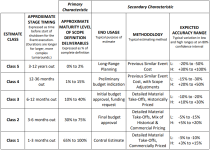- Reaction score
- 9,188
- Points
- 1,160
We also (really inconsistently) sometimes makes adjustments to some kind of future dollar values with assumptions for inflation, vice actual in year costs.
So you may take $10M today, and say it's in fact the equivalent to $15M in 2040 dollars, and then project that cost. It might make sense on some kind of CPA kind of accrual accounting thing, but when you do the budget requests you ask for whatever it will cost you that year. Sometimes they do the opposite and adjust future costs to current in year cost, sometimes they use actual costs, so it's confusing.
Normally when you do cost predictions on the project side, if you have a recurring item (like buying the same widget) you just take the current cost and apply some kind of annual assumed inflation, so that your year to year cost projections take into account normal increases over time for the same kind of work. The obvious example for that is labour and material costs. The amount of steel you need is pretty fixed, but you still want to account for normal increases over time. The amount of labour will go down over time on predictable rates (and plateau when they hit peak efficiency) but the overall costs may still increase as labour rates go up.
For example, first time you do something might take 10 hours, second time 9 hours, and then eventually get down to 6 hours the tenth time. But if your labour rate goes from $80/hour to $120 over 20 years you may pay more in dollar figures for the 10th one (realizing that the dollar is worth less 20 years out).
Trying to find a good way to explain big dollar costs on a long term strategic project is a challenge, but the way we do it inflates the sticker shock by a lot. If you told someone the cost of ownership of a $50k car was $250k (with potentially another $80k of repairs) that wouldn't really make sense to them, but that's essentially what we have to do under TBS costing rules.
So what you are saying is that any firm cost evaluation can only ever be a real time snapshot of the situation on the day the snapshot was taken.
Everything else is assumption and supposition and subject to negotiation and interpretation.
If I go back to the infamous Absalon, which the Danes claimed cost less than a Littoral Combat Ship. That might be because that is what they actually paid for the ship.
The weapons they installed they already owned in many cases and were designed for plug and play installation. That was a separately funded project that had been paid for years previously.
The munitions for the weapons were also funded by a separate project with some of the munitions, consummables, being common across the services and not tied to any particular platform or service.
The service contract was also priced, costed and reported separately.
On a given day it can be said that that hull cost XX krone to put in the water. 10 years later that information is stale and less useful. But probably more useful than the guessing on the day it was launched what the replacement value would be 10 years later and what her in-service costs would actually be.
40 year budgets really are a nonsense.






